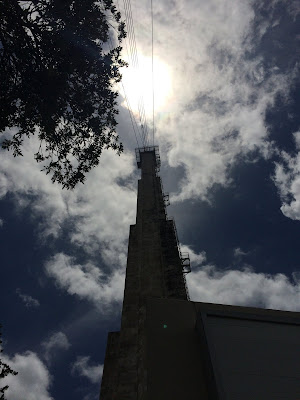During the last half of the 1980's, I was serving in the United States Navy and had the privilege of being stationed at Roosevelt Roads Naval Station on the island of Puerto Rico for two different seven-month tours. The second time was after the wrath of Hurricane Hugo had devastated the area, as we came in to help the island recover. During my first tour though, I did manage to explore various parts of this beautiful island during weekend liberties.
One of the fascinating places I saw during my many expeditions on the island was the Arecibo Observatory. In a huge natural depression in the tropical mountains above the town of Arecibo, a gargantuan radio telescope measuring one thousand feet in diameter was constructed some 57 years ago. This was the largest single radio telescope in existence until just a few years ago when China built a larger one. The Arecibo radio telescope was invaluable for scientific exploration and discoveries while monitoring electromagnetic radio frequencies from space. Indeed, even Nobel caliber work occurred at this site with work on binary pulsars. Also, if you are a James Bond fan, you might remember this site from the movie, Golden Eye.
In 2017, Hurricanes Irma and Maria further devastated the island and caused damage to this giant radio telescope. My wife and I were able to return to the island in 2019 and visit the site, which was still up and operational at the time. Unfortunately, the lack of funding and the ravages of nearly sixty years of time took its toll on this marvelous site and it experienced a catastrophic failure of one of its supporting cables that held up the Gregorian dome suspended above the dish in December of 2020. This caused a chain of events as the other cables were not able to support the sudden dynamic increase in loading as the array crashed into the dish below.
The nerd in me saw this YouTube video from Practical Engineering that tells about this extraordinary radio telescope and its subsequent demise and I had to share this as it was something that made quite an impression on me as a young man. The pictures below are ones that I took on my trip in 2019. The video follows the pictures and is worth a look. They had a drone aloft right at the time that the catastrophic failure occurred. It is at around 12 minutes and 40 seconds of this 18 minute video. Enjoy.
This is the overlook control station that is used to position the array and Gregorian dome for measurements.
It took a remarkable amount of self control to not start repositioning the Gregorian dome when I was that close to the controls. I figured I'd be about as popular as Trump at an Antifa riot if I did.
I was glad I got to see this remarkable piece of engineering again, and I am saddened by its demise this last December. Perhaps it may be rebuilt eventually. If not, it has served us well for six decades of amazing scientific discoveries and exploration!











2 comments:
Who was funding this telescope? NASA, the military, some other department?
It was originally built, I think, by the defense department to detect nuclear launches; however, the National Science Foundation took over and funded it for a long time after that. I think, as funding was cut back continuously in recent times, that a university in Florida was funding the site. I don't recall which one. The video, as I recall, gives some of that info too.
It was really cool to see. Sad that it has been destroyed by salt air and time.
Post a Comment